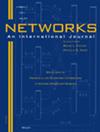Finding conserved low‐diameter subgraphs in social and biological networks
IF 1.3
4区 计算机科学
Q4 COMPUTER SCIENCE, HARDWARE & ARCHITECTURE
引用次数: 0
Abstract
The analysis of social and biological networks often involves modeling clusters of interest as在社会和生物网络中寻找保守的低直径子图
对社会和生物网络进行分析时,往往需要将感兴趣的簇群建模为小集团或其图论概型。小群模型将小群中成对相邻的要求放宽为群内有长度限制的路径,已被用于模拟社会网络中的内聚子群和生物网络中的功能模块或复合体。然而,如果图是随时间变化的,或者在不同条件下会发生变化,那么我们可能会对随时间或条件变化而保持其特性的簇感兴趣。为了模拟这种在图集合中保持不变的簇,我们考虑了一种跨图-club 模型,即在图集合中的每个图中形成一个-club 的节点子集。在本文中,我们考虑了一个典型的优化问题,即在图集合中找到一个最大心数的交叉图-俱乐部。我们开发了整数编程方法来解决这个问题。具体来说,我们引入了基于延迟约束生成的强化公式、有效不等式和分支切割算法。我们的计算研究结果表明,使用我们介绍的方法有很大的好处。
本文章由计算机程序翻译,如有差异,请以英文原文为准。
求助全文
约1分钟内获得全文
求助全文
来源期刊

Networks
工程技术-计算机:硬件
CiteScore
4.40
自引率
9.50%
发文量
46
审稿时长
12 months
期刊介绍:
Network problems are pervasive in our modern technological society, as witnessed by our reliance on physical networks that provide power, communication, and transportation. As well, a number of processes can be modeled using logical networks, as in the scheduling of interdependent tasks, the dating of archaeological artifacts, or the compilation of subroutines comprising a large computer program. Networks provide a common framework for posing and studying problems that often have wider applicability than their originating context.
The goal of this journal is to provide a central forum for the distribution of timely information about network problems, their design and mathematical analysis, as well as efficient algorithms for carrying out optimization on networks. The nonstandard modeling of diverse processes using networks and network concepts is also of interest. Consequently, the disciplines that are useful in studying networks are varied, including applied mathematics, operations research, computer science, discrete mathematics, and economics.
Networks publishes material on the analytic modeling of problems using networks, the mathematical analysis of network problems, the design of computationally efficient network algorithms, and innovative case studies of successful network applications. We do not typically publish works that fall in the realm of pure graph theory (without significant algorithmic and modeling contributions) or papers that deal with engineering aspects of network design. Since the audience for this journal is then necessarily broad, articles that impact multiple application areas or that creatively use new or existing methodologies are especially appropriate. We seek to publish original, well-written research papers that make a substantive contribution to the knowledge base. In addition, tutorial and survey articles are welcomed. All manuscripts are carefully refereed.
 求助内容:
求助内容: 应助结果提醒方式:
应助结果提醒方式:


